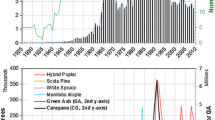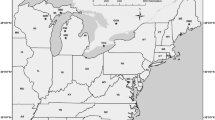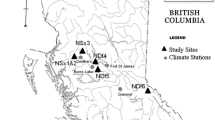Abstract
Shelterbelts have played an important role in prairie agriculture since the late 1800s; however, little is known about how these shelterbelts may be affected by climate change. The objective of this study was to determine if shelterbelt species, which are heavily influenced by human activity, express a common radial-growth signal within and between trees. The study focused on the annual tree-ring growth of the nine most common shelterbelt species of the Canadian Prairies: Salix acutifolia (Acute willow), Caragana arborescens (caragana, or Siberian pea shrub), Picea pungens (Colorado spruce), Fraxinus pennsylvanica (green ash), Populus sp. (hybrid poplar), Acer negundo (Manitoba maple), Pinus sylvestris (Scots pine), Ulmus pumila (Siberian elm) and Picea glauca (white spruce). Tree core samples were collected near Saskatoon, Saskatchewan using traditional dendrochronological methods. The standardized growth of each species was compared with historical homogenized climate data in order to determine the key monthly climate variables impacting each species. Prior to this analysis, little was known about the suitability of six of these nine species for dendrochronological purposes. It was found that all species crossdate at a significant level, and that the three most significantly correlated climate factors are able to account for up to 37 % of the annual variation in tree-ring growth. The findings of this study suggest that all nine species are suitable, to varying degrees, for future dendrochronological research in the Canadian Prairies as well as having implications for shelterbelt systems elsewhere in the world. The top four species based on four ranking criteria (interseries correlation, mean sensitivity, climate explanatory power, and commonality) were white spruce, acute willow, caragana, and Manitoba maple, and initial results suggest that all species have the potential to be investigated in greater depth.




Similar content being viewed by others
References
Agriculture and Agri-Food Canada (2008) Circling the globe with trees. AAFC No. 10772E
Biondi F, Waikul K (2004) DENDOCLIM2002: A C++ Program for statistical calibration of climate signals in tree-ring chronologies. Comput Geosci 30:303–311
Brandle J, Hodges L, Zhou X (2004) Windbreaks in North American agricultural systems. Agrofor Syst 61(1):65–78
Cook ER (1985) A time series analysis approach to tree ring standardization. Ph.D. Dissertation, University of Arizona, Tucson
Dale JE, Lewry ML (2007) Geology and geomorphology. In: Canadian plains research centre, Saskatchewan: geographic perspectives. Friesens, Altona, pp 11–28
Dixon R, Winjum J, Schroeder P (1993) Conservation and sequestration of carbon: the potential of forest and agroforest management practices. Glob Environ Change 3(2):159–173
Environment Canada (2010) Climate change—climate data and model output—adjusted and homogenized Canadian climate data temperature precipitation pressure wind contact information SiteMap proactive disclosure proactive disclosure adjusted and homogenized Canadian climate data. http://ec.gc.ca/dccha-ahccd/Default.asp?lang=En&n=B1F8423A-1. Accessed 14 Dec 2011
ESRI (2012) World Street Map: Highway-level GIS data. http://goto.arcgisonline.com/maps/World_Street_Map. Accessed 27 Aug 2012
Fritts H (1976) Tree rings and climate. Academic Press, New York
Grissino-Mayer HD (1993) An updated list of species used in tree-ring research. Tree-ring Bull 53:17–45
Grissino-Mayer HD (2001) Evaluating crossdating accuracy: a manual and tutorial for the computer program COFECHA. Tree-ring Res 57(2):205–221
Grissino-Mayer, HD (2007) Dendrochronology species database. http://www.wsl.ch/dienstleistungen/produkte/glossare/dendro_bibliography/species/index_EN?redir=1. Accessed 5 Jan 2012
Holmes RL (1983) Computer-assisted quality control in tree-ring dating and measurement. Tree-ring Bull 43:69–78
Kulshreshtha SN, Van Rees KCJ, Hesseln H, Johnston M, Kort J (2010) Issues in agroforestry development on the Canadian Prairies. In: Kellimore LR (ed) Handbook on agroforestry: management practices and environmental impact. Nova Science, New York, pp 91–127
Lin X, Barrington S, Nicell J, Choiniere D, Vezina A (2006) Influence of windbreaks on livestock odour dispersion plume in the field. Agric Ecosyst Environ 116:263–272
Liu Y, Harris D (2008) Effects of shelterbelt trees on reducing heating-energy consumption of office buildings in Scotland. Appl Energy 85:115–127
Montagnini F, Nair P (2004) Carbon sequestration: an underexploited environmental benefit of agroforestry systems. Agrofor Syst 61:281–295
Rooney T, Waller D (1998) Local and regional variation in hemlock seedling establishment in forests of the upper Great Lakes region. USA. For Ecol Manag 111(2–3):221–224
Schweingruber FH (1988) Tree rings. Basics and applications of dendrochronology. Kluwer Academic press, Dordrecht
Schweingruber FH (1996) Tree rings and environment: dendroecology. Swiss Federal Institute for Forest, Snow and Landscape Research
Stokes MA, Smiley TL (1968) An introduction to tree-ring dating. The University of Arizona Press, Tucson
Torita H, Satou H (2007) Relationship between shelterbelt structure and mean wind reduction. Agric For Meteorol 145(3-4):186–194
Tyndall J, Colletti J (2007) Mitigating swine odor with strategically designed shelterbelt systems: a review. Agrofor Syst 69(1):45–65
Tyndall J, Grala R (2008) Financial feasibility of using shelterbelts for swine odor mitigation. Agrofor Syst 76(1):237–250
VoorTech (2011) Project J2X. VoorTech consulting. http://www.voortech.com/projectj2x/. Accessed 5 Dec 2011
Wang H, Takle E (1995) A numerical simulation of boundary-layer flows near shelterbelts. Bound-Layer Meteorol 75(1–2):141–173
Acknowledgments
Funding was provided by Agriculture and Agri-food Canada’s Agricultural Greenhouse Gases Program (AGGP), NSERC USRA (Davis), and NSERC Discovery Grant (Laroque and Van Rees). We thank Georgia Bock, Graham Clark, Steven Hall, Emily Hogan, Cecilia Jennings, Geoff Kershaw, Bryan Mood, and Sarah Quann for assistance in sampling and laboratory analysis, as well as the anonymous reviewers for their valuable feedback.
Author information
Authors and Affiliations
Corresponding author
Rights and permissions
About this article
Cite this article
Davis, E.L., Laroque, C.P. & Van Rees, K. Evaluating the suitability of nine shelterbelt species for dendrochronological purposes in the Canadian Prairies. Agroforest Syst 87, 713–727 (2013). https://doi.org/10.1007/s10457-012-9591-8
Received:
Accepted:
Published:
Issue Date:
DOI: https://doi.org/10.1007/s10457-012-9591-8




